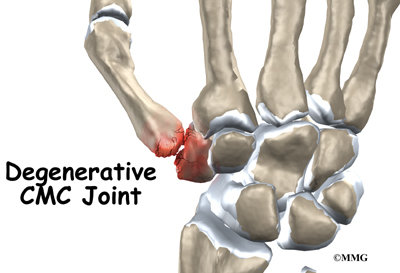

With over 100 diseases and conditions within the rheumatic diseases, “arthritis is the leading cause of disability in the United States” (Cooper, 2014, p. 457).
“Arthritis can be caused by infection, trauma, degeneration, metabolic disorders, autoimmune diseases, and various systemic diseases” (USDHHS, 2021).
Symptoms
- Shooting/Sharp pain
- Achy joints
- Stiffness
- Inflammation
- Weakness
- Joint deformity
- Radial/Ulnar deviation of fingers
Osteoarthritis
Osteoarthritis (OA) is sometimes called the wear-and-tear disease due to the breakdown of the articular cartilage along with the resulting changes of the underlying bone (Cooper, 2014). This can occur due to both mechanical (physical stress/overuse/anatomical design) and chemical factors (body chemistry/physiology).
Within the cartilage, chondrocytes fail to maintain a necessary balance of extracellular matrix. This results in poor shock absorption within the articular cartilage. Hyaline cartilage is also known as Articular cartilage, and is designed to withstand compression. When force is applied to the hyaline cartilage, the pressure is absorbed by the ground substance and proteoglycans which deforms the cartilage when water is pushed out of the cartilage. When pressure is relieved, the cartilage regains it’s hardness and original form when the proteoglycans draw that water back in.
Since the proteoglycans maintain the stiffness, their maintenance is crucial for proper hyaline cartilage function (Gornaik, 2015). The collagen fibers resist tensile and shear stress, where proteoglycans and water ground substance resist compression.
Since hyaline cartilage is avascular (no blood supply) it depends on this process of loading and unloading to gain its nutrients. When this occurs, the water and nutrients are drawn in and out. This means that not only overuse but underuse can cause damage to hyaline cartilage. With overuse or muscle imbalance, these proteoglycans can become spread out, resulting in a loss of stiffness, permeability, and waste and nutrient exchange (Radomski et al., 2014).
Effect on Bone
Outside of joint degeneration, new bone formation is also common. This is known as osteophytosis, which can cause pain and limited range of motion. Bone spurs (osteophytes) at the base of the fingers can result in trigger finger where the finger locks in place when flexed. Nodules at the PIP joint can are known as Bouchard’s nodes, and nodules on the DIP are known as Heberden’s nodes. Other deformities associated with OA are mallet finger, deviation of joints, swan neck deformity, and boutonniere deformity (USDHHS, 2021).
Recommendations
Osteoarthritis is nothing to mess with, always consult your physician to determine the severity and what is appropriate for you as an individual. Everyone has different levels of severity. What might be right for you, might not work for someone else. It is recommended to avoid overuse, and maintain proper joint mobility through gentle passive and active stretching. Aggressive stretching could cause damage to unstable joints.
There are several types of joint replacements and procedures available which have associated protocols based on the materials and strategies utilized for those procedures. Contact your doctor for recommended protocols for the specific procedure utilized for your hand if you’re looking for exercises. What may seem like a simple exercise could compromise your surgery so BE CAREFUL!
For online classes, proven stretches, evidence based research, and useful modalities for arthritis click the link below!
References
Cooper, C. (2014). Fundamentals of hand therapy: Clinical reasoning and treatment guidelines for common diagnoses of the upper extermity (2nd edition). Elsevier Mosby
Radomski, M.V., Trombly Latham, C.A. (2014). Occupational therapy for physical dysfunction, 7th edition. Philadelphia, PA. Lippincott. ISBN: 978-1-4511-2746-1.
U.S. Department of Health and Human Services. (2021, February 22). NIAMS Health Information on Osteoarthritis. National Institute of Arthritis and Musculoskeletal and Skin Diseases. https://www.niams.nih.gov/health-topics/osteoarthritis.

